
Westchester County is a county located in the southeastern portion of the U.S. state of New York, bordering the Long Island Sound to its east and the Hudson River on its west. The county is the seventh most populous county in the State of New York and the most populous north of New York City. According to the 2020 United States Census, the county had a population of 1,004,456, its highest decennial count ever and an increase of 55,344 (5.8%) from the 949,113 counted in 2010. Westchester covers an area of 450 square miles (1,200 km2), consisting of six cities, 19 towns, and 23 villages. Established in 1683, Westchester was named after the city of Chester, England. The county seat is the city of White Plains, while the most populous municipality in the county is the city of Yonkers, with 211,569 residents per the 2020 census. The county is part of the Hudson Valley region of the state.

Greenburgh is a town in western Westchester County, New York. The population was 95,397 at the time of the 2020 census. The town consists of 6 villages and an unincorporated area.
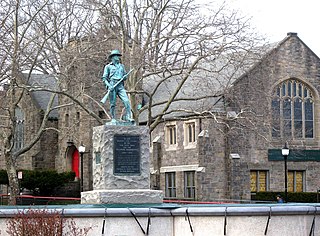
Mount Vernon is a city in Westchester County, New York, United States. It is an inner suburb of New York City, immediately to the north of the borough of the Bronx. As of the 2020 census, Mount Vernon had a population of 73,893, making it the 24th-largest municipality in the state and largest African-American majority city in the state. Mount Vernon has 12,898 Jamaicans with African and Indian descent that had immigrated from their homeland of Jamaica after the country gained its independence from Britain on August 6, 1962.

Eastchester is a town in southern Westchester County, New York, United States. The population was over 34,641 at the 2020 United States census over 32,363 at the 2010 census. There are two villages within the town: Bronxville and Tuckahoe. The town contains a census-designated place also named Eastchester, which is the whole town of Eastchester excluding Bronxville and Tuckahoe.

Mount Vernon is a neighborhood of Baltimore, Maryland, located immediately north of the city's downtown. It is named for George Washington's Mount Vernon estate in Virginia, as the site of the city's Washington Monument.

Sunnyside (1835) is a historic house on 10 acres along the Hudson River, in Tarrytown, New York. It was the home of the American author Washington Irving, best known for his short stories, such as "Rip Van Winkle" (1819) and "The Legend of Sleepy Hollow" (1820).

Saint Paul's Church National Historic Site is a church and National Historic Site in Mount Vernon, New York, just north of the New York City borough of the Bronx. Established in 1765, Saint Paul's Church is one of New York's oldest parishes and was used as a military hospital after the American Revolutionary War Battle of Pell's Point in 1776. The 5-acre (20,000 m2) cemetery surrounding the church contains an estimated 9,000 burials dating from 1704. The church and cemetery were designated as a United States National Historic Site in 1978 to protect them from increasing industrialization of the surrounding area.
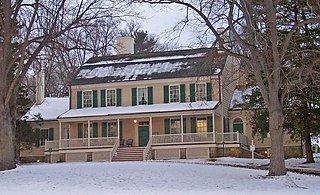
The John Jay Homestead State Historic Site is located at 400 Jay Street in Katonah, New York. The site preserves the 1787 home of Founding Father and statesman John Jay (1745–1829), one of the three authors of The Federalist Papers and the first Chief Justice of the United States. The property was designated a National Historic Landmark in 1981 for its association with Jay. The house is open year-round for tours.

The John A. Hartford House, now known as Hartford Hall, is a historic house on the campus of Westchester Community College. It was built in 1930–32 by John A. Hartford (1872–1951), company president of the Great Atlantic and Pacific Tea Company (A&P). The house was designated a National Historic Landmark in 1977 for its association with Hartford, who oversaw the rise of A&P into the nation's first national chain grocer. The building now houses the office of the college president, among other uses.

Usonia Historic District is a planned community and national historic district in the Town of Mount Pleasant, adjacent to the village of Pleasantville, Westchester County, New York. In 1945, a 100-acre (0.40 km2) rural tract was purchased by a cooperative of young couples from New York City, who were able to enlist the students of Frank Lloyd Wright to build his Broadacre City concept. Wright decided where each house should be placed. Wright designed three homes himself and approved architectural plans of the other 44, which were designed by such architects as Paul Schweikher, Theodore Dixon Bower, Ulrich Franzen, Kaneji Domoto, Aaron Resnick and David Henken – an engineer and Wright apprentice.
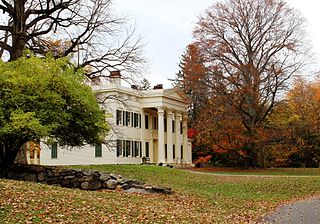
The Jay Estate is a 23-acre park and historic site in Rye, New York, with the 1838 Peter Augustus Jay House at its center. It is the keystone of the Boston Post Road Historic District, a National Historic Landmark District (NHL) created in 1993. The site is one of two surviving remnants of the 400-acre (1.6 km2) farm where US Founding Father, John Jay, grew up, the other intact parcel being the Marshlands Conservancy. It is also the place where Jay returned to celebrate the end of the American Revolutionary War, after he negotiated the 1783 Treaty of Paris with fellow peacemakers John Adams and Benjamin Franklin. The preserved property is located on the south side of the Boston Post Road and has a 3⁄4-mile (1.2 km) view of Milton Harbor.
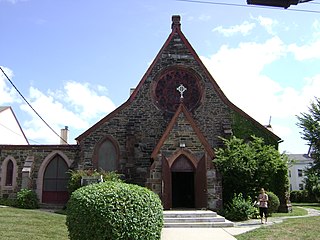
Trinity Episcopal Church Complex is a historic Episcopal church complex at 335 Fourth Avenue in Mount Vernon, Westchester County, New York. It is two blocks south of its mother church, Saint Paul's Church. The complex consists of the church (1859), old parish hall (1892), new parish hall, and rectory (1893). The church, old parish hall, and new parish hall are connected to form an L-shaped building. The church was designed by Henry Dudley and built in the Gothic Revival style and enlarged and substantially redecorated in the 1880s. It is a one-story masonry structure with a steeply pitched, slate covered gable roof.

US Post Office-Mount Vernon is a historic post office building located at Mount Vernon in Westchester County, New York, United States. It was built in 1915 and is one of a number of post offices designed by the Office of the Supervising Architect under direction of Oscar Wenderoth. It is a two to three story, symmetrical building faced with limestone in the Classical Revival style. It is composed of a five bay central section with flanking one bay recessed wings.
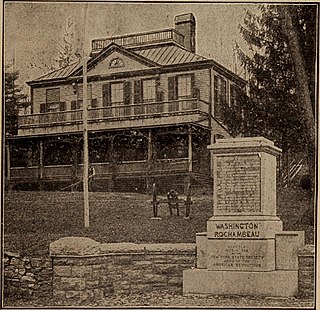
Hyatt-Livingston House was an historic home located at Dobbs Ferry, Westchester County, New York, at the corner of Colonial Avenue and Broadway. Originally constructed as part of the Philipsburg Manor around 1690 by land baron Frederick Philipse, the house was at first a smaller tenant-farmer's dwelling home to the John Hyatt family. In 1705, Hyatt's daughter Elizabeth married neighbor John Dobbs, who originally brought that family name to the area and perhaps started the ferry for which the village is named. In the early 18th century, the house was enlarged to a five-bay, 2+1⁄2-story dwelling that then formed the central part of the house. It was of wood-frame construction, with a gable roof, and sat on a fieldstone foundation.
Merestead, also known as the former Sloane Estate, is a historic home located at Mount Kisco, Westchester County, New York.

Mount Kisco Municipal Complex is a national historic district located at Mount Kisco, Westchester County, New York. The district contains two contributing buildings; the Mount Kisco Town and Village Hall (1932) and the United States Post Office (1936). Both are in the Colonial Revival style. The Town and Village Hall is a 2-story, cruciform plan brick building on a limestone foundation and topped by a slate-covered hipped and gable roof. It features an octagonal clock tower. The Village Library formerly occupied the second floor until a separate, adjacent building was constructed in the 1960s. The first floor formerly housed the police station and a small jail. The Post Office is a 1+1⁄2-story brick building set on a limestone foundation and topped by a slate shingle clad gable roof. It consists of a central section flanked by 1-story wings, with a large 2-story rear wing. The interior features murals depicting the history of Mount Kisco executed by artist Thomas Donnelly in 1936.

Presbyterian Rest for Convalescents, also known as the Y.W.C.A. of White Plains and Central Westchester, is a historic convalescent home located at White Plains, Westchester County, New York. It was built in 1913, and is a 3+1⁄2-story, H-shaped building in the Tudor Revival style. The two lower stories are in brick and the upper stories in half-timbering and stucco. It has a tiled gable roof with dormer windows. The section connecting the two wings includes the main entrance, which features stone facing and Tudor arches. The connected Acheson Wallace Hall was built in 1972. The building housed a convalescent home until 1967, after which it was acquired by the Y.W.C.A. and operated as a residence for women.
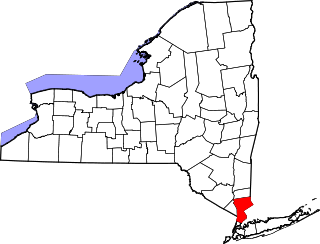
This is a list of the National Register of Historic Places listings in southern Westchester County, New York, excluding the cities of New Rochelle and Yonkers, which have separate lists of their own.
There are numerous nationally and locally designated historic sites and attractions in Westchester County. These include architecturally significant manors and estates, churches, cemeteries, farmhouses, African-American heritage sites, and Underground Railroad depots and waystations. There are sites from pre-Revolutionary and Revolutionary times, as well as battlegrounds. Westchester County also played an important role in the development of the modern suburb, and there are many associated heritage sites and museums.

The African American Heritage Trail of Westchester County in New York was created in 2004 to help preserve and interpret the historic landmark places that help tell the narratives of women and men of African descent who have made significant contributions to an American identity. The initial list had 13 sites. Westchester County historian and Schulman History Honoree Dr. Larry Spruill was lead consultant and researcher for the project.






















